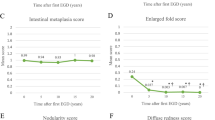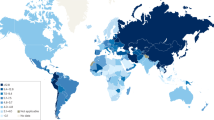Abstract
Gastroenterologists can be frustrated, at times, by surgical pathology reports of gastritis that either do not match what was seen endoscopically, or do not indicate the presence of a specific disease. This might be because of one or more factors. First, it has been well established that the correlation between the endoscopic diagnosis of gastritis and histologic gastritis is poor. Second, there are a limited number of well-known histologic gastritides that yield specific diagnoses. Reports that are purely descriptive are, therefore, common, and might require discussion between endoscopist and pathologist.
Key Points
-
Good endoscopic–histologic correlation for gastric biopsies is to be expected only ∼50% of the time
-
Endoscopically normal mucosa often has histologic inflammation, and endoscopically inflamed mucosa is often histologically normal
-
Pathology reports of gastritis can be divided into two broad groups: specific gastritis diagnoses and descriptive nonspecific diagnoses
-
Specific diagnoses are more likely when clinical and endoscopic information and clinical questions are sent with the biopsy to the pathology laboratory
-
Clinicians should ask the pathologist for an explanation when they receive a histologic diagnosis of gastritis that does not match any of the described gastritides
This is a preview of subscription content, access via your institution
Access options
Subscribe to this journal
Receive 12 print issues and online access
$189.00 per year
only $15.75 per issue
Buy this article
- Purchase on SpringerLink
- Instant access to full article PDF
Prices may be subject to local taxes which are calculated during checkout





Similar content being viewed by others
References
Fung WP et al. (1979) Endoscopic, histological and ultrastructural correlations in chronic gastritis. Am J Gastroenterol 71: 269–279
Toukan AU et al. (1985) Gastroduodenal inflammation in patients with nonulcer dyspepsia. A controlled endoscopic and morphometric study. Dig Dis Sci 30: 313–320
Gad A (1986) Erosion: a correlative endoscopic histopathologic multicenter study. Endoscopy 18: 76–79
Elta GH et al. (1987) A study of the correlation between endoscopic and histological diagnoses in gastroduodenitis. Am J Gastroenterol 82: 749–753
Fenoglio-Preiser CM (1999) Gastrointestinal Pathology: An Atlas and Text, edn 2. Philadelphia: Lippincott Williams & Wilkins,
Moayyedi P et al. (2000) Changing patterns of Helicobacter pylori gastritis in long-standing acid suppression. Helicobacter 5: 206–214
Redeen S et al. (2003) Relationship of gastroscopic features to histological findings in gastritis and Helicobacter pylori infection in a general population sample. Endoscopy 35: 946–950
Miyamoto M et al. (2003) Nodular gastritis in adults is caused by Helicobacter pylori infection. Dig Dis Sci 48: 968–975
Presotto F et al. (2003) Helicobacter pylori infection and gastric autoimmune diseases: is there a link? Helicobacter 8: 578–584
Pashankar DS et al. (2002) Chemical gastropathy: a distinct histopathologic entity in children. J Pediatr Gastroenterol Nutr 35: 653–657
Sobala GM et al. (1990) Reflux gastritis in the intact stomach. J Clin Pathol 42: 303–306
Frezza M et al. (2001) The histopathology of non-steroidal anti-inflammatory drug induced gastroduodenal damage: correlation with Helicobacter pylori, ulcers, and haemorrhagic events. J Clin Pathol 54: 521–525
El-Zimaity HM et al. (1996) Histological features do not define NSAID-induced gastritis. Hum Pathol 27: 1348–1354
De Giacomo C et al. (1994) Lymphocytic gastritis: a positive relationship with celiac disease. J Pediatr 124: 57–62
Wolber R et al. (1990) Lymphocytic gastritis in patients with celiac sprue or spruelike intestinal disease. Gastroenterology 98: 310–315
Wu T-T and Hamilton SR (1999) Lymphocytic gastritis: association with etiology and topology. Am J Surg Pathol 23: 153–158
Dixon MF et al. (1988) Lymphocytic gastritis—relationship to Campylobacter pylori infection. J Pathol 154: 125–132
Hayat M et al. (1999) Effects of Helicobacter pylori eradication on the natural history of lymphocytic gastritis. Gut 45: 495–498
Oberhuber G et al. (1997) Focally enhanced gastritis: a frequent type of gastritis in patients with Crohn's disease. Gastroenterology 112: 698–706
Wright CL and Riddell RH (1998) Histology of the stomach and duodenum in Crohn's disease. Am J Surg Pathol 22: 383–390
Parente et al. (2000) Focal gastric inflammatory infiltrates in inflammatory bowel diseases: prevalence, immunohistochemical characteristics, and diagnostic role. Am J Gastroenterol 95: 705–711
Sharif F et al. (2002) Focally enhanced gastritis in children with Crohn's disease and ulcerative colitis. Am J Gastroenterol 97: 1415–1420
Xin W and Greenson JK. (2004) The clinical significance of focally enhanced gastritis. Am J Surg Pathol 28: 1347–1351
Genta RM et al. (1993) Changes in the gastric mucosa following eradication of Helicobacter pylori. Mod Pathol 6: 281–289
Author information
Authors and Affiliations
Corresponding author
Ethics declarations
Competing interests
The authors declare no competing financial interests.
Rights and permissions
About this article
Cite this article
McKenna, B., Appelman, H. Primer: histopathology for the clinician—how to interpret biopsy information for gastritis. Nat Rev Gastroenterol Hepatol 3, 165–171 (2006). https://doi.org/10.1038/ncpgasthep0420
Received:
Accepted:
Issue date:
DOI: https://doi.org/10.1038/ncpgasthep0420



